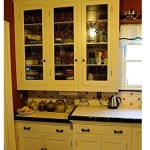Oil for Kitchen Cabinets: A Guide to Choosing the Right Finish
Kitchen cabinets are a significant investment and a focal point of the kitchen. Their finish plays a crucial role in their overall appearance, durability, and longevity. Oil-based finishes have long been a popular choice for kitchen cabinets, offering a range of benefits. However, understanding the nuances of oil finishes and selecting the right one for your specific needs is essential to achieving a beautiful and long-lasting result.
Types of Oil Finishes
Several types of oil finishes are available, each with its own characteristics and applications. Some common options include:
- Tung Oil: Known for its durability and natural, water-resistant properties. Tung oil penetrates deep into the wood, creating a hard and protective finish.
- Linseed Oil: A traditional oil finish that dries to a durable, water-resistant finish. It is available in boiled and raw forms, with boiled linseed oil drying faster and being more durable.
- Danish Oil: A blend of oils and resins, Danish oil offers a beautiful satin finish and good water resistance. It is easier to apply than pure oils and dries relatively quickly.
- Mineral Oil: A colorless, odorless oil used primarily for food-grade applications. It can be used on cutting boards and other surfaces that come into contact with food but is not recommended for general cabinet finishes due to its lack of durability.
Benefits of Oil Finishes for Kitchen Cabinets
Oil finishes offer numerous benefits for kitchen cabinets, making them a popular choice for homeowners and professionals alike:
- Natural Beauty: Oil finishes enhance the natural grain and color of wood, creating a warm and inviting aesthetic.
- Durability: Oil finishes form a protective layer that shields wood from moisture, scratches, and stains. This durability makes them ideal for high-traffic areas like kitchens.
- Repairable: Unlike painted cabinets, oil-finished cabinets can be easily repaired. Simply sand down the damaged area and apply a fresh coat of oil.
- Food-Safe: Many oil finishes, such as tung and linseed oil, are food-safe and can be used on surfaces that come into contact with food.
Considerations When Choosing Oil Finishes
While oil finishes offer various advantages, there are certain considerations to keep in mind when selecting one for your kitchen cabinets:
- Drying Time: Oil finishes can take several days to dry completely, depending on the type of oil, temperature, and humidity. This can be a factor if you need the cabinets to be functional quickly.
- Maintenance: Oil-finished cabinets require regular maintenance, including periodic cleaning and re-oiling, to maintain their beauty and protection.
- Shine Level: Depending on the type of oil and application technique, oil finishes can produce a variety of shine levels, from matte to satin to gloss. Consider the desired look for your kitchen.
Applying Oil Finishes to Kitchen Cabinets
Applying oil finishes to kitchen cabinets requires careful preparation and application techniques. Here's a general process:
- Preparation: Ensure the cabinets are thoroughly cleaned and free of dust, grease, or previous finishes. Sand the surfaces with fine-grit sandpaper to create a smooth and even surface.
- Application: Apply the oil finish with a clean cloth or brush in thin, even coats. Let each coat dry thoroughly before applying the next. Follow the manufacturer's instructions for drying times and application techniques.
- Finishing Touch: Once the final coat has dried, you can use a soft cloth to buff the cabinets to enhance the shine and create a smooth finish.
By understanding the different types of oil finishes, their benefits, and the considerations involved, you can choose the best option for your kitchen cabinets. With proper care and maintenance, oil-finished cabinets can provide a beautiful, durable, and long-lasting solution for your kitchen. Remember to always consult with a professional if you have any doubts or concerns about applying oil finishes to your kitchen cabinets.

Best Paint For Cabinets Oil Enamel Or Hybrid

Choosing Kitchen Cabinet Paint Oil Based Paints Vs Water Or Latex

How To Clean Grimy Kitchen Cabinets With 2 Ingredients

Kitchen Cabinets Best Paint For Oil Based Waterbased Cleaning Tsp Woodworker S Journal

Pull Out Spice Cabinet With Oils And Vinegars Narrow Kitchen Lake House

How To Clean Wood Kitchen Cabinets Like A Boss Shelfgenie

Kitchen Design Inspiration For The Main House Lesley W Graham

How To Remove Thick Grease From Kitchen Cabinets

5 Places To Use Oil Based Paint

Water Based Vs Oil Paints Which Is Better For Kitchen Cabinets
Related Posts








